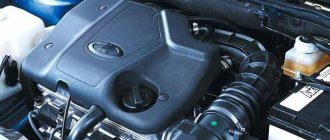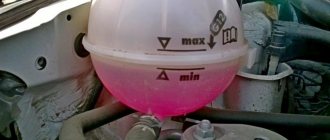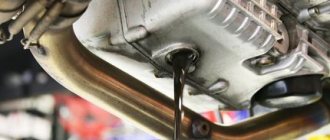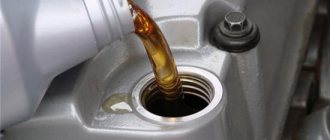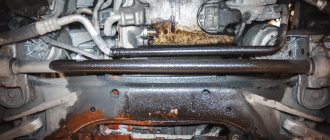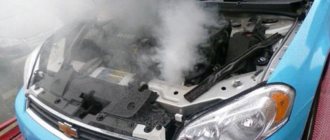Any internal combustion engine needs high-quality lubrication and cooling - it is these systems that determine how long the heart of the car - its power unit, which is exposed to extreme loads - will work. The working substance in both the cooling system and the lubrication system are technical fluids, which are fundamentally different in their characteristics. Therefore, their circulation lines in the engine do not intersect, which prevents their mixing and loss of performance properties. To ensure this mode of operation, the designers had to work hard, but overall this system works very well. Provided everything is in order. But the reality is that any mechanical device will eventually wear out and break down. Since a modern car engine consists of thousands of parts, assemblies and assemblies, the likelihood that over time one of them will fail increases as the vehicle ages.
Failure of certain components of the power plant can lead to the fact that the tightness of the cooling system is broken, and in this case, antifreeze begins to leak. In certain cases, such a leak can lead to its entry into the lubrication system.
We will tell you in what cases this happens, what threatens the engine, and how to detect and fix the problem in time.
Signs
If antifreeze gets into the oil, how can you tell? There are several signs to look out for:
- Coolant level. On a serviceable engine, it should not be changed during operation. However, if the level decreases, albeit slightly, this may indicate that antifreeze is getting into the engine oil.
- Traffic fumes. The exhaust becomes whiter and thicker. When the engine operates, a specific steam is generated. But you need to understand that this phenomenon is considered normal in severe frost. However, if the temperature outside is above zero, this is a clear sign that antifreeze is getting into the oil.
- Candles. The electrodes of the spark plugs will be filled with antifreeze and will emit a characteristic odor.
- Oil. If antifreeze gets in, it changes its color and structure. Usually the oil turns almost white.
- Emulsion on the oil filler neck. It may resemble a thick “mayonnaise”.
Fault detection
This problem, or rather, a serious breakdown, is quite insidious and does not appear immediately. Liquid lubricant passes through microcracks in small portions, without having a particular effect on the operation of the power unit. Changes become noticeable at the next stage, when the channel connecting the two systems expands and the mixing speed increases.
How to determine whether lubricant has gotten into antifreeze:
- due to the deterioration of the cooling properties of antifreeze, the engine begins to heat up more often, the electric fan operates more often;
- the oil level gradually decreases, and the antifreeze level increases (it’s quite difficult to notice);
- the pump impeller whips up the oil-water mixture, turning it into a thick white emulsion that clogs the filter, causing the engine lubricant pressure to drop;
- drips are visible on the outside of the block or heat exchanger body, originating near the gasket (they do not always appear);
- the oil in the expansion tank changes the color and consistency of the coolant.
Important! The most obvious sign of mixing, monitored visually, is a white emulsion in the expansion tank with antifreeze. If you find a similar substance in the tank, compare this fact with other symptoms - constant overheating of the engine and signals from the oil level warning lamp.
As a rule, trouble does not come alone. Antifreeze that gets into the oil pan can create serious problems: at best, the emulsion will clog the lubricating channels and filter. In the worst case scenario, the crankshaft will rotate the bearings (sliding bearings) as a result of oil starvation. Expensive repairs are guaranteed.
Often the gasket bursts all the way to the cylinder walls, after which antifreeze gets into the combustion chambers (its channels are closer). The sign of a breakdown is clearly visible - white smoke pours out of the exhaust pipe in large quantities, and the engine power drops sharply.
When a similar problem occurs on a machine equipped with a heat exchanger - a motor lubricant cooler, diagnostic difficulties arise. If there are no external signs in the form of drips, then after identifying the emulsion in the expansion tank, it is better to contact a car service center. There, both units will be purged with a special installation and the culprit will be determined by air leakage.
About the white coating on candles
If a white coating has formed on the spark plugs, the reasons may be different. First of all, this indicates problems with fuel quality. But if it is a rough white coating on the spark plugs, the reasons are due to overheating of the engine. Also, similar soot forms if:
- The spark plug is not suitable for this engine (by heat rating or other parameters).
- The inlet pipe is leaking. Here air will be taken in from outside.
- Poor ignition calibration.
- There are problems with the cooling system (for example, a faulty radiator).
Taxonomy
Taxonomic position
Taxonomic scheme
(according to APG II System):
| 17 more families, including sedges, cattails | about 15 more tribes, including the feather grass , oat family , and bluegrass | Two-row barley, maned barley, mouse barley and other types | |
| order Poaceae, or Poagrass | subfamily Poagrass | genus Barley | |
| Department Flowering, or Angiosperms | family Poaceae, or Poagrass | tribe Wheat | dbl Common barley |
| 44 more orders of flowering plants | five more subfamilies, including Bamboo, Rice | 26 more genera, including Rye, Wheatgrass, Wheatgrass, Wheat |
Intraspecific taxa
The following subspecies are distinguished:
- Hordeum vulgare subsp. spontaneum - Wild barley basionym
- — Six-row barley
Two widespread cultivated varieties of common barley are two-row barley, native to Western Asia, and six-row barley, native to East Asia. In both varieties, the spikelets sit in threes on both sides of the spike shaft, forming six longitudinal rows along the spike. However, in two-row barley, like in wild barley, only two of the six spikelets sitting next to each other are fertile, from which caryopsis develops, the other four are sterile and reduced to glumes, so two rows of grains ripen on the ear, and four rows of scales are visible - according to two rows on both sides of the ear. In six-row barley, all six adjacent spikelets are fertile, and a ripe spike has six rows of grains.
Why does coolant seep into the oil?
Experts identify several reasons for this phenomenon:
- Deformation of the gasket that separates the block and cylinder head. This is the answer to the question of where the antifreeze goes if it doesn’t leak anywhere. The internal combustion engine has separate channels for coolant. But their isolation is incomplete due to the presence of breaks at the junction of the block and the cylinder head. To ensure a seal, a gasket is installed. This also prevents oil leakage. But if the cylinder head gasket is broken (the symptom is an emulsion in the oil), then antifreeze will penetrate the lubrication system. The element breaks due to burnout. Also, if the cylinder head gasket is blown, the symptoms will be as follows: a drop in coolant level and characteristic white smoke from the exhaust.
- Defects on the cylinder head. The key role here is not played by the head itself, but rather by the area adjacent to the cylinder block. If there is deformation in one of the areas, the tightness of the gasket will deteriorate. Even if the latter is not damaged, due to insufficient sealing, antifreeze enters the oil. This problem is complicated by the fact that it cannot be noticed immediately. Where does antifreeze go if it doesn't leak anywhere? It is mixed in small volumes with oil. And head deformation can be detected only after troubleshooting. This requires a specialized tool. The head is placed on the edge and the evenness is determined with a metal ruler. If a defect is detected, the head is ground.
- Defects in the block body. This applies to sections of channels where antifreeze circulates. This problem is the most serious, since the engine has to be removed from the car.
How does lubricant get into antifreeze (antifreeze)?
The cooling system of the power unit is a network of channels passing through the block and cylinder head. It is sealed and therefore operates under pressure resulting from the heating and expansion of the liquid. The lubrication system has a similar structure, only the channels are narrower, and the pressure is created by an oil pump.
There are only 3 reasons why two different liquids are mixed:
- The gasket between the head and the cylinder block is the weak point of any engine. When the smallest crack appears in it, liquid with higher pressure penetrates into the “foreign” system. As a rule, oil enters the antifreeze because the oil pump “presses” harder than the pump. Although mutual penetration also happens.
- In cars with powerful and more complex engines, there is an element for cooling the engine lubricant - an oil cooler. In it, too, mixing of antifreeze and oil occurs as a result of a breakdown of the gasket.
- Cracks in the metal of the cylinder head itself.
Now about why the integrity of the gaskets is compromised. The main enemy of any motor and additional elements is overheating. When exposed to high temperatures, the aluminum cylinder head or oil heat exchanger housing is deformed. But since the part is firmly held by bolts, longitudinal expansion of the metal occurs, pulling the gasket along with it. Cracks appear in the latter, where the lubricant penetrates.
The opposite situation also happens: antifreeze flows into the engine and dilutes the oil in the crankcase. The reason is a malfunction of the pressure relief valve installed in the expansion tank plug. Then antifreeze penetrates through the cracks, since its pressure is greater.
What to do if coolant gets into the oil?
So, having determined the cause of the problem, you can begin repairs. The easiest option is to replace the head gasket. But this is only done if it burns out. To do this, the cylinder head is removed, the area is cleared of the old gasket, a new one is installed and the bolts are tightened to the appropriate torque. As practice shows, antifreeze no longer gets into the oil. In this case, repair costs will be minimal.
But the most difficult stage in the work is the removal and subsequent installation of the cylinder head. In this case, you will need a torque wrench. The bolts must be tightened in accordance with the diagram (usually crosswise). The tightening torque is individual for each vehicle.
It would be useful to troubleshoot the head. If there are imperfections on the surface, sanding will be required. But it is performed only on specialized equipment. You can’t do this without the help of a master. If the head is “worried” (for example, due to severe overheating), then grinding may not help. In such a situation, you only need to install a new head. The same goes for the block. If there are cracks on it, the block needs to be replaced.
How to fix the problem?
There are several ways to deal with the problem. Some manipulations are very complex and to solve them you should contact a service station, while some are easy to do yourself. The solution to the problem can be as follows:
- A burnt gasket can be easily replaced. It is quite possible to do this at home. True, here you will have to remove the cylinder head and have a torque wrench on hand.
- Grind the block head. This is only available for minor deformations. If the cylinder head is seriously damaged, then it will have to be changed.
- Performing or replacing the cylinder block.
The two extreme operations cannot be performed with your own hands. This will require serious equipment. It’s better to hire a master for the job. It is important to remember that “self-medication” can lead to the real problem and other damage.
How to change the gasket?
Let's consider the replacement procedure using the example of a VAZ-2109 car. To do this we need:
- Remove the air filter housing.
- Disconnect all fuel supply hoses and power wires.
- Drain the coolant.
- Unscrew the manifold.
- Disconnect high-voltage wires.
In this way, we free the head from everything unnecessary, so that nothing gets in the way when removing. To unscrew the head itself you need a powerful wrench and a hexagon. A total of ten bolts need to be unscrewed. The latter are removed along with the washers. Next, the head carefully rises up. It is important not to distort it. The gasket itself may remain on the head or stick to the block. You can remove it with your own hands or pry it off with a negative screwdriver. The surface of the cylinder head is inspected for corrosion. If there is rust, it will need to be milled and sanded. If all is well, you need to remove traces of the old gasket. Having cleared the surface of its residues, degrease the area.
Oil cooler failure
An oil cooling system is necessary for a car to maintain the lubricant at a temperature that is comfortable for the car to operate. If the oil cooler tubes are damaged and this system depressurizes, oil gradually begins to leak into the coolant. The first signal that the problem with your breakdown is in the oil cooler is the appearance of oil with bubbles in the coolant.
In this case, it is necessary to remove the pipes from the oil cooler, wash them and connect them together. The expansion tank of the system also needs to be completely cleaned. After these manipulations, the liquid is refilled. After a short period of time after restarting the car, you need to check whether the problem has disappeared or not. If yes, then the repair will cost you a little less, since you will have to deal exclusively with the cooler.
The coolant reservoir is dirty with grease
After removing the cooling system, you should thoroughly check all the pipes and, if there are cracks, weld them. This part of the work should be left to professionals. Poor quality repairs will end up costing you even more. Most often, copper tubes of the appropriate diameter are simply inserted into the places where cracks form in the oil cooler.
Sometimes oil gets into the antifreeze due to the fault of service station employees. If you discovered such a problem after visiting the station, it is worth checking whether engine oil has been added to the cooling system of your car. To do this, the liquid from the oil cooler is completely drained, and the system itself is thoroughly washed. In the final part of the work, you just need to pour new antifreeze into the engine.
What's next?
Install a new gasket. When installing, you need to pay attention to the fact that the gasket coincides with the guides that are on the corners of the block itself. Next, the block head is mounted. It is important that the gasket does not move during this process. Next, tighten the bolts with a torque wrench in three stages:
- 20-25 Nm.
- 70-85 Nm.
- 120 Nm. Afterwards the bolts are tightened with a force of 140 Nm.
At the next stage, all attachments are assembled, and the car will be ready for use. When starting for the first time, you need to warm up the internal combustion engine to operating temperatures, and only after that make the first trip.
Washing features
If antifreeze gets into the oil, you need to understand that the engine will need to flush the systems. The first step is to rinse the circle through which the coolant moves. To do this, you need a special solution, which can be found in auto stores. The product is poured into the expansion tank and the engine is started for 10 minutes. When the fan turns on, you can complete the flushing.
After this, the old antifreeze is drained. Pre-prepare a container with a volume of at least five liters. Next you need to remove the oil cooler (if the car has one). It is removed differently on different machines. After dismantling, you need to thoroughly clean it and install new seals.
Next, the expansion tank is removed. It needs to be washed. Distilled water is poured into the motor and the engine starts. After the engine has warmed up, you need to turn on the interior airflow. The stove should work for about 10 minutes. Then the engine is turned off. Drain the liquid. After this, you can already fill in fresh antifreeze. Sometimes an air lock forms in the system. To remove it, you need to open the expansion tank cap and squeeze the SOD pipe.
Please note that flushing the system is carried out after installing the new gasket. At the same time, the oil also changes.
Elimination method
When a significant amount of lubricant gets into the antifreeze, the latter is unable to work as a coolant. It forms clots and even solid particles that settle on the walls of the channels, clogging the thermostat valve and clogging the radiator. There is also no guarantee that mutual penetration has not occurred and antifreeze has not leaked into the oil pan. Hence the conclusion: both liquids must be drained .
If your car is equipped with an oil cooler, immediately contact a service station to locate the broken gasket. Then decide whether to carry out the repairs yourself or entrust the work to car service personnel.
What to do if oil or emulsion is found in the expansion tank with antifreeze:
- Both systems need to be flushed. Before draining the antifreeze, add a special detergent composition to the expansion tank and let the engine idle for 5 minutes. Empty the lubrication system immediately.
- Unscrew and discard the oil filter.
- Replace the gasket on the cylinder block by removing the cylinder head. During the dismantling process, disassemble the elements of the cooling system (pipes, pump, thermostat) and thoroughly rinse them by hand. Do the same with the heat exchanger if it is the culprit for mixing liquids.
- Unscrew the oil pan and oil pump, disassemble the latter and change all gaskets. Before assembly, wash the parts with gasoline or solvent.
- Assemble the power unit, install a new filter and fill in engine flushing lubricant. Instead of antifreeze, fill the system with distilled water and add detergent.
- Start the engine and let it run for 10–15 minutes without increasing the speed. Keep an eye on the oil warning light and temperature gauge.
- When finished, replace the water with a working fluid - antifreeze, and the flushing oil - with full-fledged engine oil. It is highly advisable to change the filter twice.
Advice. When pre-flushing the cooling system before eliminating the malfunction, monitor the temperature and pressure of the lubricant. If you notice something is wrong, immediately turn off the engine, as the oil still gets into the antifreeze.
No matter how carefully you try to wash the engine parts during disassembly, you will not be able to get to all the channels. Therefore, flushing is performed several times, including after starting the power unit. During further operation, monitor the condition of the process fluids so that the problem does not recur.
Consequences of driving with a broken gasket
It is prohibited to operate a vehicle where antifreeze gets into the oil. What is the reason? The liquid itself, despite its toxicity, does not harm the engine. But the danger is posed by ethylene glycol, which is contained in the coolant. If it mixes with oil, the result is abrasive particles. Because of this, there is a risk of scoring.
What happens when antifreeze gets into the cylinder block? Then it interacts with the oil, and deposits are formed in the form of an emulsion. This leads to a decrease in the diameter of the channels. Lubricant and antifreeze are not able to circulate normally. As a result, the engine runs with insufficient oil pressure and overheats. The oil filter also becomes significantly dirty.
The oil itself, diluted with coolant, loses its lubricating and protective properties. This reduces the resource of the internal combustion engine and threatens high repair costs.
Consequences of oil contamination with antifreeze for the engine
The coolant is a mixture of alcohol and distilled water. If such liquid gets into the engine oil, it is quite obvious that the lubricating properties of the latter will deteriorate as a result of dilution with antifreeze. The longer this mixing lasts, the worse the MM will lubricate the rubbing parts of the power unit.
It is not difficult to predict that the consequences of antifreeze getting into the oil will be far from optimistic: accelerated wear of engine parts will lead to the need for premature engine overhaul, which is complex and expensive. If for owners of cars with high mileage and age, “capital maintenance” is, it’s fashionable to say, a routine operation, then the need to restore a fairly fresh engine can be a very unpleasant surprise for the car owner.
If there is a depressurization of the cooling system, in which coolant penetrates into the cylinders, and the driver did not notice this (which is quite likely), then with further operation of the car, quite soon clearly audible knocking noises will begin to be heard in the engine area. This is the result of wear on the crankshaft/camshaft bearings.
The mechanism for the occurrence of knocking is as follows:
If antifreeze begins to leak from the oil through the cylinders, the first to feel the deterioration in the lubrication properties of the MM are the liners, which are essentially slightly modified, highly loaded plain bearings. They are available both on the camshaft and on the crankshaft of the power unit. Poor quality lubrication will lead to the formation of scuffs on the inner surface of the liners, which will only increase over time. They are the source of bearing knocking.
If you disassemble the engine and remove the liners, you will find that the friction layer on their surface is practically absent, but there are quite deep scratches and burrs (bulges). Due to overheating, the color of the liner changes from gray to mottled brown.
If you continue to examine the surface of the bearings under a microscope, which provides a very high (thousand-fold) magnification, you will notice microscopic white balls with diameters of about 25-35 microns on the surface of the bearings. It is these particles that are responsible for the formation of scratches: at high speeds of rotation of the shafts they... Like a plow, they bite into the surface of the bearings, leaving grooves and burrs of appropriate sizes.
With such aggressive behavior, the friction layer’s chances of remaining unharmed tend to zero. You may ask, where did these balls come from, since at first they were not there? Let's figure it out.
According to spectrographic studies, these round abrasive particles consist of a mixture of sulfur, phosphorus, calcium and other elements. Although it is not a metal, the hardness of these particles is higher than that of the friction layer. So he is the one who suffers first.
Over time, the balls, which also experience heavy loads, become so compact that they become harder than the material used to make the liners. Then they attack the bearings themselves, destroying their surface.
Where did the particles come from? It turns out that it comes from additives contained in all modern oils. But the catalyst for their precipitation and grouping into large formations is antifreeze.
Plus, of course, high temperature. A verbal description of this process is not very informative, since we have little idea at what speed all these metamorphoses occur on a running engine, to what temperatures its rubbing parts heat up.
The second most important consequence of mixing oil and antifreeze in the engine is the formation of an emulsion, which is facilitated by the active mixing of these two liquids at high speeds. Why is this happening? As we already know, the coolant contains a considerable amount of water. And if oil is practically insoluble in water, then the same cannot be said about additives. This means that by partially dissolving in antifreeze, they reduce their concentration in the lubricating fluid. It is noteworthy that a minimum amount of coolant is required to start such a process.
Let us remember once again that all these processes occur at high temperatures. As they know in chemistry courses, thermal energy promotes the occurrence of various reactions between substances. That is why it does not take much time to form sufficiently strong compounds of phosphorus, sulfur, potassium, and zinc in the oil. The main condition is that antifreeze gets into the MM.
Mixing motor lubricant with engine coolant is a critical malfunction that requires immediate intervention and elimination. In other words, the car cannot be operated, only repaired. Although infrequent, this problem occurs on new and used cars. To avoid costly repairs, the car owner must clearly understand the procedure for his actions when oil is found in antifreeze.
Let's sum it up
So, we found out why antifreeze gets into the oil. As practice has shown, this problem can be identified in time by the car owner. The main signs are a characteristic white exhaust and a drop in the level of antifreeze in the tank. If liquid penetrates oil, the latter changes its structure. This is determined by the probe. In addition, suspicions may be reinforced by the wet electrode on the spark plugs and the characteristic sweet smell of antifreeze on them. We looked at the reasons for antifreeze in oil. You should not continue to operate such a car. This type of engine overheats easily. In addition, it will work with bad oil, which has lost all its positive properties. The cost of repairs will depend on the nature of the problem. This could be a gasket, head or block. In the latter case, the cost of rebuilding the engine will be the most significant.
fb.ru
Reasons for getting there
If you study the structure of a car engine, it becomes clear that the coolant circulates through the so-called jacket, removing excess heat. These channels do not normally communicate with the internal cavities, but at the junctions of different parts (especially where the cylinder head is connected to the block itself) there are weak spots and breaks. A special gasket is installed in this place, which becomes a connecting link and prevents antifreeze leakage. However, it often burns out as it wears out and the coolant leaks out or into the cylinders, sometimes in both directions.
Through such damage to the gasket, coolant enters the cylinders.
Often the problem occurs due to the fact that the cylinder head has defects along the plane that is pressed against the block. The slightest deviation creates microscopic cracks through which antifreeze is released under pressure. Well, the third reason is a crack in the channels on the block.

